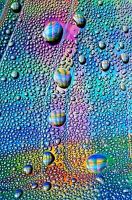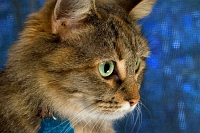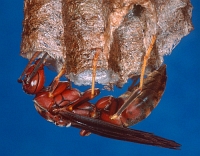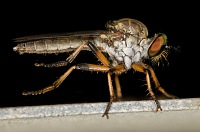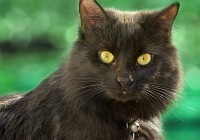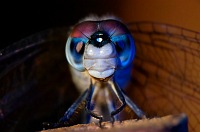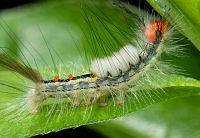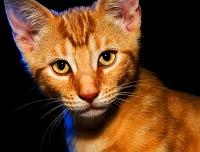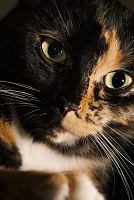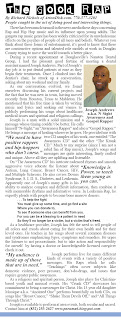Riding on the edge between Photojournalism and Documentary Photography, professional photographer 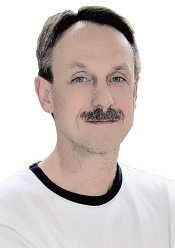 Greg Knobloch of Hiram Georgia pursues his art and craft every day, often under extreme pressure. After all, his work is seen and used by literally thousands and perhaps millions of people as he documents the daily struggles and successes of research scientists, politicians, doctors, adults and children– people from all walks of life. Greg is the only contract photographer for the CDC (Centers for Disease Control and Prevention) here in Atlanta. Technically he works for Computer Sciences Corporation but in reality he spends his working hours serving the CDC. While his bio-medical coworker usually concentrates on Microbiology using photomicroscopy, Greg concentrates on recording the people and events surrounding world health-oriented scientific research.
Greg Knobloch of Hiram Georgia pursues his art and craft every day, often under extreme pressure. After all, his work is seen and used by literally thousands and perhaps millions of people as he documents the daily struggles and successes of research scientists, politicians, doctors, adults and children– people from all walks of life. Greg is the only contract photographer for the CDC (Centers for Disease Control and Prevention) here in Atlanta. Technically he works for Computer Sciences Corporation but in reality he spends his working hours serving the CDC. While his bio-medical coworker usually concentrates on Microbiology using photomicroscopy, Greg concentrates on recording the people and events surrounding world health-oriented scientific research.
People– it’s people doing things that I shoot mostly. These research scientists, doctors and support personnel are a very dedicated group of altruistic people whose sense of mission is amazing," says Knobloch. "They could have chosen much more financially rewarding jobs in the private sector but they find their rewards in serving humanity and working with their collegues here at the CDC. It is my job to record and depict– in whatever way I can– the daily goings-on there.
Those "daily goings-on" are often in the forefront of national and international news as scientists work feverishly to prepare for the next big epidemic of diseases such as influenza. A Google search on Greg’s name will quickly bring up a wide variety of his work for important organizations such as the United States Department of Health & Human Services and the CDC NCEH National Center for Environmental Health.
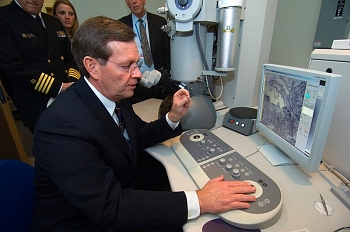 Here we see Greg’s photo of Secretary of Health & Human Services Mike Leavitt looking at the H5N1 virus on an Electron microscope. This is the notorious "bird flu" strain. Greg is called upon daily to photograph dignitaries, visiting scientists and doctors, and people from all over the world who take part in researching, fighting and preventing a variety of diseases. Sometimes he photographs new medical devices developed by CDC doctors and scientists in the course of their studies.
Here we see Greg’s photo of Secretary of Health & Human Services Mike Leavitt looking at the H5N1 virus on an Electron microscope. This is the notorious "bird flu" strain. Greg is called upon daily to photograph dignitaries, visiting scientists and doctors, and people from all over the world who take part in researching, fighting and preventing a variety of diseases. Sometimes he photographs new medical devices developed by CDC doctors and scientists in the course of their studies.
People often wonder if Knobloch is at personal risk since he (like so many dedicated CDC employees) works with scientists in close physical proximity to some very potent diseases. The answer is "no." He stays outside the "high containment" areas and shoots his photographs at a safe distance through glass windows and walls that separate him from the activity inside the labs.
The number of requests for photographs coming from both inside and outside the CDC can be overwhelming with just two photographers available. According to Greg, they could easily use an additional photographer to handle the work load, so assignments are carefully scrutinized and prioritized.
One of the most interesting projects I’ve been involved with was the Pan Flu Epidemic Exercise," says Greg. "This was an exercise that concerned the CDC’s response to a serious Influenza Epidemic. It’s not really a question of ‘if’ an influenza epidemic will occur, but ‘when’ and the CDC works very hard with extensive planning to best be able to deal with such a serious outbreak. Much of what I covered occurred at the Emergency Operations Center which was visually very interesting. There is a beehinve of activity.
In the course of Greg’s work, his photo duties provide opportunities to create a wide variety of visuals using whatever light is available on location. That is the photographer’s first duty, to observe the light available and make quick decisions as to what equipment is needed to compensate for any short-comings that the environment may pose.
Sometimes he has the oppportunity to use flash equipment, but for 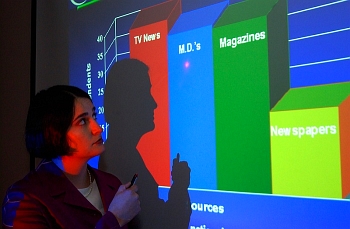 many purposes he uses available light and a high ISO setting on either his 12 megapixel Nikon D2x or his Nikon D200 camera.
many purposes he uses available light and a high ISO setting on either his 12 megapixel Nikon D2x or his Nikon D200 camera.
Both feature Nikon’s advanced matrix metering (which emulates the Zone System) and an 18-200mm vibration-reduction (VR) lens. He says he can get good usable results up to ISO 1600 on either of these higher-end SLRs, depending upon how the picture will ultimately be used. Using vibration reduction lenses allows him to take sharp pictures with very slow shutter speeds, as low as a 25th of a second hand-held.
In this presentation bar chart photo he has taken the opportunity to use only the light from the presentation projector to maximize the impact of the presenter’s subject matter. All of us discover sooner or later that flash photography doesn’t work in this situation. This image was used for a CDC print publication.
As we began this story, I mentioned that Greg is both a photojournalist and a documentary photographer. Both of these career definitions fall under the broader field of editorial photography. Editorial photography consists of photographs made to illustrate a story or idea within the context of a newspaper, magazine or other form of publishing. Photojournalism is a more specific subset of editorial photography:
According to the Wikipedia,
Photojournalism is a particular form of journalism (the collecting, editing, and presenting of news material for publication or broadcast) that creates images in order to tell a news story. It is now usually understood to refer only to still images, and in some cases to video used in broadcast journalism. Photojournalism is distinguished from other close branches of photography (such as documentary photograpy, street photography or celibrity photography) by the qualities of:
Timeliness – the images have meaning in the context of a published chronological record of events.
Objectivity – the situation implied by the images is a fair and accurate representation of the events they depict.
Narrative – the images combine with other news elements, to inform and give insight to the viewer or reader
Given this definition, much of what Knobloch does is photojournalistic. However, he states that his job involves "documenting" the daily proceedings of the CDC. The Wikipedia defines documentary photography in this way:
Documentary photography usually refers to a type of professional photojournalism, but it may also be an amateur or student pursuit. The photographer attempts to produce truthful, objective, and usually candid photography of a particular subject, most often pictures of people. The pictures usually depict a certain perspective of the photographer.
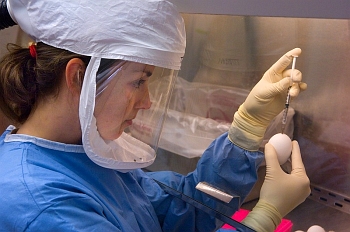 That last sentence is important because typically a photojournalist records and depicts reality just as a reporter would without manipulating the images other than exposure, contrast and minimal enhancements to make usable declarative images of facts and events. On the other hand, a documentarian takes a point of view, inserts an opinion, depicts a concept or perfects the visual image to make a statement, even if it is nothing more than using Photoshop on an image to brush the hair out of someone’s eyes.
That last sentence is important because typically a photojournalist records and depicts reality just as a reporter would without manipulating the images other than exposure, contrast and minimal enhancements to make usable declarative images of facts and events. On the other hand, a documentarian takes a point of view, inserts an opinion, depicts a concept or perfects the visual image to make a statement, even if it is nothing more than using Photoshop on an image to brush the hair out of someone’s eyes.
Pure photojournalists are expected to leave things as they are originally recorded in presenting images as close to the unbiased truth as possible (although philosophers would argue that every point of view is biased).  Some photojournalists refuse to crop their images for fear that their objectivity might be compromised. Documentarians are not bound by such rules and can present the subject matter in its best light. You might say that a documentarian depicts events to illustrate a point of view. Given this idea, a documentary photographer is permitted to elicit a visual expression without clear boundaries. This means that photo illustration and photo manipulation are certainly permitted and encouraged. Adobe Photoshop is in!
Some photojournalists refuse to crop their images for fear that their objectivity might be compromised. Documentarians are not bound by such rules and can present the subject matter in its best light. You might say that a documentarian depicts events to illustrate a point of view. Given this idea, a documentary photographer is permitted to elicit a visual expression without clear boundaries. This means that photo illustration and photo manipulation are certainly permitted and encouraged. Adobe Photoshop is in!
An organization such as the CDC and its huge matrix of related organizations certainly need newsworthy photojournalism, 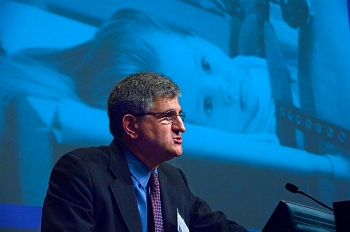 but they also need to illustrate and explain what is happening in the worlds of health and disease and this is what makes Knobloch’s career a photographer’s dream.
but they also need to illustrate and explain what is happening in the worlds of health and disease and this is what makes Knobloch’s career a photographer’s dream.
So how did Mr. Knobloch find his calling in photography? Born in Bay City, Michigan, he remembers being impressed at an early age by his father’s enthusiasm for taking color family photos. In the late ’70s, Greg graduated with a 4 year degree in business from Northwood University in Midland Michigan. Eventually he served an enlistment in the armed forces in Korea where he began practicing the hobby of photography with a Nikon F2.
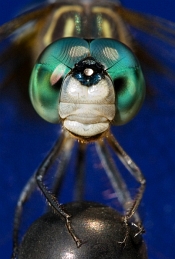 Upon arriving in Atlanta he entered the Art Institute of Atlanta where he studied photography for 2 years. After graduating he became a photo instructor and taught part time in the evening for many years at AIA while assisting professional photographers around Atlanta and freelancing on a variety of projects. This led to a 15 year position doing tourism and travel photography for the state of Georgia.
Upon arriving in Atlanta he entered the Art Institute of Atlanta where he studied photography for 2 years. After graduating he became a photo instructor and taught part time in the evening for many years at AIA while assisting professional photographers around Atlanta and freelancing on a variety of projects. This led to a 15 year position doing tourism and travel photography for the state of Georgia.
About 7 years ago Knobloch submitted his resume on-line to Monster.com and landed a position with a company that had a contract with the CDC, during a time when the federal government began outsourcing certain positions. Today he works for Computer Sciences Corporation who holds the current contract with the CDC.
A typical day for me might start with a photo session of a group of visiting doctors from Thailand, or perhaps a meeting of legislators. Then I might cover a conference or set up in the studio for a photo of a lady at a table eating cereal with folic acid additives. During the day I might be required to take a number of people and face shots for use in CDC publications. I almost always photograph people, lots of them– scientists in labs, high profile doctors studying a variety of topics such as hepatitis. I might take a portrait of a medical officer, be whisked away to make anothrer group photo. The people I work with every day are cooperative, appreciative and are just plain nice folks.
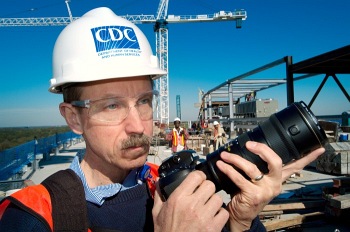 Some of Greg’s CDC photographs are available free of charge to the public as part of the Public Health Image Library (PHIL). This extensive image collection is copyright free for the most part. It is useful to scientific and legal communities, health care providers, teachers, trainers, photo librarians and researchers, biomedical and public relations personnel, students and consumers. Just follow the link to a great image resource.
Some of Greg’s CDC photographs are available free of charge to the public as part of the Public Health Image Library (PHIL). This extensive image collection is copyright free for the most part. It is useful to scientific and legal communities, health care providers, teachers, trainers, photo librarians and researchers, biomedical and public relations personnel, students and consumers. Just follow the link to a great image resource.
Photographers are always in need of portable light sources. For flash equipment Knobloch frequently carries 3 Nikon speedlights with him. He finds their built-in wireless controls a necessity. He usually uses one light on camera for fill, trying not to use it as the main light if at all possible.
As I mentioned earlier, Greg is taken with his Nikon DSLRs (Digital Single Lens Reflex cameras). Once he figured out that he can use a high quality SLR with an ISO of 800 to 1600, a VR (vibration reduction) lens and slow shutter speeds in low light, he stopped taking along a tripod. He also uses constant aperture Nikkor F2.8 zoom lenses. He relishes the instant feedback that digital cameras provide to insure that he gets the shot every time. He hasn’t used a film camera in quite some time.
Greg’s personal work shows his passion for macro, pet and abstract photography. For him, its not just a career, its a lifestyle. He enjoys using Photoshop masks, layers and curves to bring out the subtle changes and nuances that make up fine art imagery. Here are a few of his personal favorites:
|
Click on the images below to enlarge them |
||
|
|
||
Knobloch takes his self-assignments seriously. One of the CDC influences apparent in Greg’s work is his fascination with macro photography. When time permits he explores the worlds inside worlds, especially insects. His equipment includes a lens-mounted wireless Nikon R1D1 close-up speedlight system which can comes with 2 Nikon R-200 speedlight units, but can easily hold 3 or more flash heads with colored filters attached to enhance definition and add color to various parts of tiny subjects. As you can see from the center column of photos above, Greg has several cats which provide him an endless treasure trove of interesting imagemaking opportunities. Using his exacting flash system and proper exposure, he can bring out every detail in the cat’s fur without causing an over-powering glow in the animal’s eyes.
I’m sure there will be many changes in photography over the next 50 years at an ever-increasing pace. Sensors for digital cameras are bound to change quite a bit. Currently, it appears that if current ISO ranges are to be maintained, pixels on digital sensors can’t be made smaller for increased resolution without generating increased noise. I would expect to see new and improved sensor technologies evolve. Nikon seems likely to introduce full frame sensors soon. If I were able to do things better in my job, one thing that comes to mind is archiving and organizing the photography. I’m hard-pressed just to keep up with day-to-day assignments and back-up the images. Being able to catalog all of the image files so that they could be readily retrieved according to category and subject is a luxury I wish I had.
Greg takes time from his busy schedule to keep up with technology. He recommends the following resource links for those who aspire to better themselves in this fascinating art and craft:
|
National Association of Photoshop Professionals |
The NAPP has terrific resources. Membership includes very informative semi-monthly magazines, a website with great training articles and more; numerous training videos, seminars and other publications are available. This association is affiliated with PhotoshopUser.com. |
|
an excellent source for information and tips |
|
|
great for seeing what is new and has excellent reviews |
|
|
very good for reviews and technical articles |
|
|
very good reviews, lens & camera evaluations and technical articles |
|
|
has helpful reviews and articles on their website. You can also subscribe to the printed edition. |
|
|
great images, excellent technical articles and reviews |
I would like to thank Mr. Knobloch, the CDC and the Public Health Image Library for their cooperation and resources in making this article possible. All healthcare images shown here are in the public domain.
All images in the personal work section of this article are copyrighted by Greg Knobloch with all rights reserved. If you have questions or comments please leave them below. Thank you!
Richard Nichols, ArtonDisk.com ? July, 2007 by Art on Disk Corporation

